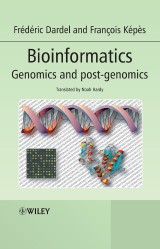Details

Bioinformatics
Genomics and Post-Genomics1. Aufl.
|
67,99 € |
|
| Verlag: | Wiley |
| Format: | |
| Veröffentl.: | 11.01.2007 |
| ISBN/EAN: | 9780470020029 |
| Sprache: | englisch |
| Anzahl Seiten: | 272 |
DRM-geschütztes eBook, Sie benötigen z.B. Adobe Digital Editions und eine Adobe ID zum Lesen.
Beschreibungen
This book is an excellent introductory text describing the use of bioinformatics to analyze genomic and post-genomic data. It has been translated from the original popular French edition, which was based on a course taught at the well-respected École Polytechnique in Palaiseau. This edition has been fully revised and updated by the authors. <p>After a brief introduction to gene structure and sequence determination, it describes the techniques used to identify genes, their protein-coding sequences and regulatory regions. The book discusses the methodology of comparative genomics, using information from different organisms to deduce information about unknown sequences. There is a comprehensive chapter on structure prediction, covering both RNA and protein. Finally, the book describes the complex networks of RNA and protein that exist within the cell and their interactions, ending with a discussion of the simulation approaches that can be used to model these networks.</p> <p>Praise from the reviews:</p> <p><i>“In context of the new developments the genomic era has brought, Bioinformatics: Genomics and Post-Genomics becomes a fundamental and indispensable resource for undergraduate and early graduate students…insightfully authored…will immensely help students…in establishing important foundations while shaping their careers.”</i> NEWSLETTER, BRITISH SOCIETY OF CELL BIOLOGY</p>
Chapter 1. Genome sequencing. <p>1.1 Automatic sequencing.</p> <p>1.2 Sequencing strategies.</p> <p>1.3 Fragmentation strategies.</p> <p>1.4 Sequence assembly.</p> <p>1.5 Filling gaps.</p> <p>1.6 Obstacles to reconstruction.</p> <p>1.7 Utilizing a complementary ‘large’ clone library.</p> <p>1.8 The first large-scale sequencing project: The Haemophilus influenzae genome.</p> <p>1.9 cDNA and EST.</p> <p>Chapter 2. Sequence comparisons.</p> <p>2.1 Introduction: Comparison as a sequence prediction method.</p> <p>2.2 A sample molecule: the human and rosterone receptor.</p> <p>2.3 Sequence homologies - functional homologies.</p> <p>2.4 Comparison matrices.</p> <p>2.5 The problem of insertions and deletions.</p> <p>2.6 Optimal alignment: the dynamic programming method.</p> <p>2.7 Fast heuristic methods.</p> <p>2.8 Sensitivity, specificity, and confidence level.</p> <p>2.9 Multiple alignments.</p> <p>Chapter 3. Comparative genomics.</p> <p>3.1 General properties of genomes.</p> <p>3.2 Genome comparisons.</p> <p>3.3 Gene evolution and phylogeny: applications to annotation.</p> <p>Chapter 4. Genetic information and biological sequences.</p> <p>4.1 Introduction: Coding levels.</p> <p>4.2 Genes and the genetic code.</p> <p>4.3 Expression signals.</p> <p>4.4 Specific sites.</p> <p>4.5 Sites located on DNA.</p> <p>4.6 Sites present on RNA.</p> <p>4.7 Pattern detection methods.</p> <p>Chapter 5. Statistics and sequences.</p> <p>5.1 Introduction.</p> <p>5.2 Nucleotide base and amino acid distribution.</p> <p>5.3 The biological basis of codon bias.</p> <p>5.4 Using statistical bias for prediction.</p> <p>5.5 Modeling DNA sequences.</p> <p>5.6 Complex models.</p> <p>5.7 Sequencing errors and hidden Markov models.</p> <p>5.8 Hidden Markov processes: a general sequence analysis tool.</p> <p>5.9 The search for genes - a difficult art.</p> <p>Chapter 6. Structure prediction.</p> <p>6.1 The structure of RNA.</p> <p>6.2 Properties of the RNA molecule.</p> <p>6.3 Secondary RNA structures.</p> <p>6.4 Thermodynamic stability of RNA structures.</p> <p>6.5 Finding the most stable structure.</p> <p>6.6 Validation of predicted secondary structures.</p> <p>6.7 Using chemical and enzymatic probing to analyze folding.</p> <p>6.8 Long-distance interactions and three-dimensional structure prediction.</p> <p>6.9 Protein structure.</p> <p>6.10 Secondary structure prediction.</p> <p>6.11 Three-dimensional modeling based on homologous protein structure.</p> <p>6.12 Predicting folding.</p> <p>Chapter 7. Transcriptome and proteome: macromolecular networks.</p> <p>7.1 Introduction.</p> <p>7.2 Post-genomic methods.</p> <p>7.3 Macromolecular networks.</p> <p>7.4 Topology of macromolecular networks.</p> <p>7.5 Modularity and dynamics of macromolecular networks.</p> <p>7.6 Inference of regulatory networks.</p> <p>Chapter 8. Simulation of Biological Processes in the Genome Context.</p> <p>8.1 Types of simulations.</p> <p>8.2 Prediction and explanation.</p> <p>8.3 Simulation of molecular networks.</p> <p>8.4 Generic post-genomic simulators.</p> <p>Index.</p>
"...provides a clear and concise introduction to the popular new science of bioinformatics." (<i>Bioautomation</i>, volume 7)
<b>Frédéric Dardel.</b> LCRB - UMR8015 CNRS, Faculté de Pharmacie, Université René Descartes/Paris. <p><b>François Képès.</b> Epigenomics Project, Genopole®, Bldg G3, 93 rue Henri Rochefort, 91000 Evry, France.</p> <p>Translated by Noah Hardy.</p>

















